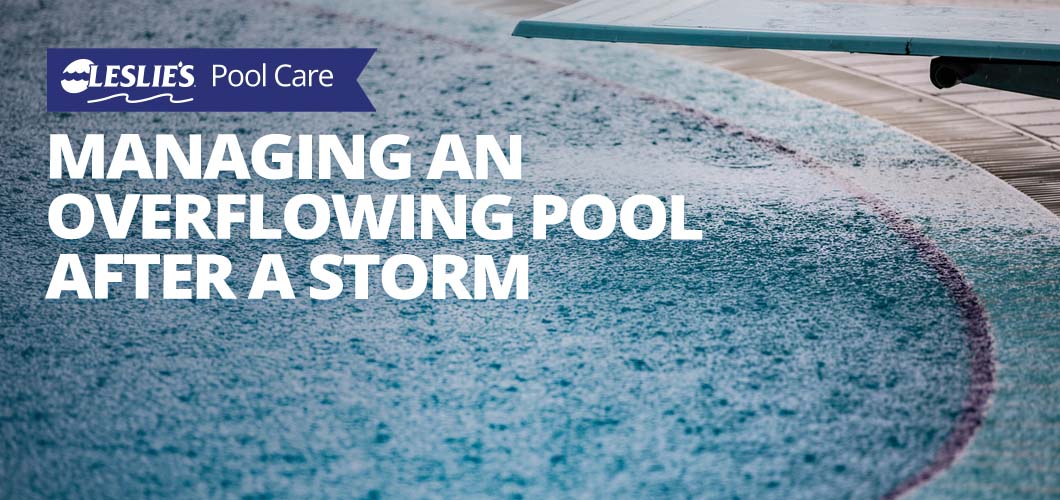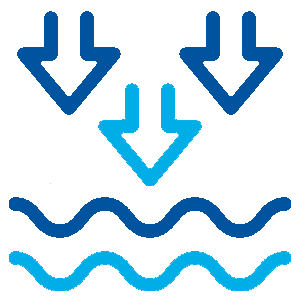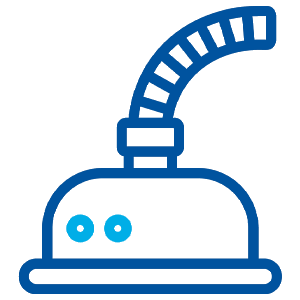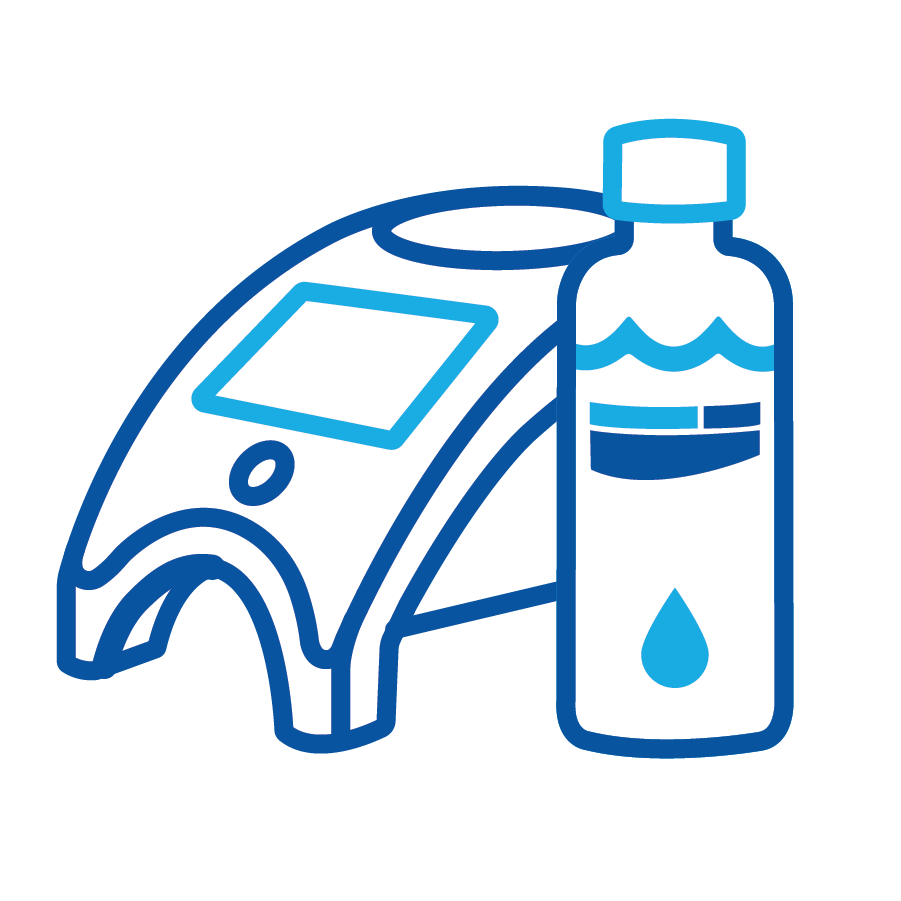
Managing an Overflowing Pool After a Storm
Severe weather events, such as heavy rains, floods, and storms, can cause numerous complications for your pool and pool equipment. From clogged filters to algae-filled water, and everything in between, there's no telling what damage Mother Nature might inflict. In this article, we'll discuss the common post-storm dilemma of an overflowing pool. And while extra water in your pool might not seem like a reason to worry, this situation can quickly go from bad to worse. Keep reading to learn more.
Initial Steps to Take
An overflowing pool can lead to imbalanced water chemistry, dilution of chemicals, insufficient sanitization, equipment malfunctions, and an increase in contaminants and debris. As a result, the pool can quickly become a dirty, cloudy, mess that's unsafe for swimming.
If your inground pool floods, don't wait for the water to evaporate on its own. The longer you wait to address the pool, the greater the chance that bacteria, algae, and other unhealthy contaminants will take up residence. Once the storm passes and the skies are blue, follow these steps to get your pool back on the right track:
1. Turn Off Power

2. Remove Excess Water

3. Check for Damage

1. Turn Off Power
Even if there's only a little bit of flooding around the pool, prioritize safety by shutting off the electricity and gas to your pool equipment before you start working on the pool. Given the dangerous combination of water and electricity, it’s crucial to eliminate any risks for yourself and others. In case of any water damage, turning off the power ensures a safe environment while you address the flood situation.
2. Remove Excess Water
If your pool is overflowing, you'll need to remove water from the pool so the waterline sits halfway up the opening of the skimmer. If the surrounding area is still flooded, you'll obviously need to wait until the water levels recede before you can start lowering the water level in your own pool.
There are a few ways to partially drain your pool, but the easiest is to use a submersible pump or a siphon. To use a submersible pump, simply attach a hose to the pump, set the pump into your pool, and place the end of the hose in your designated draining area. Just be mindful to always follow local regulations when draining any water from your pool.
PRO TIP: Thinking of draining your pool or lowering the water level before a major storm to avoid an overflowing pool? Well, DON'T! The water in your pool helps weigh down the pool structure and equalizes the pressure from the surrounding underground water table. As rainfall from a storm saturates the ground, the water table rises, and the upward pressure against your pool increases. If the pool is empty, this pressure can cause the entire structure to pop right out of the ground.
3. Inspect Your Pool for Damage
After returning the water level to normal, give the pool and equipment a thorough once-over to check for any damage caused by the storm. Inspect the pump, other equipment, and plumbing for water damage, leaks, or cracks. Then, empty out the skimmer and pump strainer baskets. Finally, check the walls and floor of your pool for any issues with the pool structure. If any large debris made its way into the pool, make sure it didn't damage your pool surfaces.
If you find any serious damage to the pool structure or pool equipment, call a pool service professional immediately for a more thorough inspection and repair.
PRO TIP: Dealing with a malfunctioning pump after a severe storm? Don't worry! While this situation is far from ideal, it's not the end of the world! You can still tend to your overflowing pool and take care of business even without your equipment. Check out our article, How to Maintain a Pool With Damaged Equipment, for more information.
Clean, Balance, and Circulate the Pool Water
With the excess water removed and any structural damage addressed, the next steps will help you get your pool swim-ready once again. You'll need to:
Clean the Pool

Test and Balance Chemistry

Run the Pump and Filter

Skim, Brush, and Vacuum the Pool
Start the cleaning process by using a leaf net to scoop up large debris, trash, and anything else that blew into your pool during the storm. Then, grab your pool brush and vigorously brush the walls, steps, and floor of your pool, paying special attention to corners. Once you've loosened all the dirt and particulates, manually vacuum your pool or use your automatic cleaner to help with the cleanup process.
Test and Balance Water Chemistry
After cleaning every inch of your flooded pool, it's time to focus on restoring water chemistry balance. Use an at-home water test, such as AccuBlue Home®, a test kit, or test strips to analyze the water chemistry and adjust the levels as needed. After a heavy rain, Total Alkalinity and pH levels are most likely to change, and you may have issues with elevated phosphate levels or metals because of pool water overflow.
- Metals: Rainwater and pool overflow can bring trace levels of metals into your pool. While small amounts of metals — anything less than 0.2 ppm — is generally nothing to worry about, higher levels can cause extensive staining in your pool. Before you even think about shocking the water or adjusting water chemistry, be sure to check and address the metal content first to avoid staining issues.
- pH: Imbalanced pH can pose a myriad of issues both to you and your pool. For example, it can impact chlorine effectiveness, cause uncomfortable swimming conditions, and even facilitate staining, scaling, and corrosion of pool and equipment surfaces. The ideal range for pH in pool water is 7.4–7.6. To balance pH in your pool, use Soda Ash to increase levels or Dry Acid to decrease levels.
- Total Alkalinity (TA): When the Total Alkalinity level is out of whack, the pH level also becomes unstable, which can lead to corrosion, stains, and cloudy water. The ideal range for TA ranges between 80–120 ppm (parts per million), depending on which type of sanitizer you use. If levels are below 80 ppm, use Alkalinity Up. And if levels are above 120 ppm, use Dry Acid or Muriatic Acid.
- Phosphates: Phosphates are the primary food source for algae, and numbers typically spike after a heavy rainfall because of the extra phosphate-containing debris that winds up in the pool. Phosphates are commonly found in plant debris and household gardening products, such as fertilizers and potting soil. In the event of a flood or an overflowing pool, phosphates from the surrounding area can more easily find their way into the water. Use a phosphate remover like Leslie's NoPHOS to keep phosphate levels as close to 0 ppb (parts per billion) as possible, but at least under 100 ppb to avoid problems with algae.
EXPERT TIP: While at-home test kits and strips are handy for day-to-day quick maintenance tests, nothing compares to the precision of Leslie's AccuBlue testing system. Whether you bring a water sample into your local store or enroll in an AccuBlue Home membership, the revolutionary 10-point water analysis and corresponding treatment plan will help you maintain a clean, safe, and beautiful pool no matter the situation. AccuBlue also checks for phosphates and metals, which aren't included in most water tests.
Shock the Pool Water
With the pool water chemistry balanced, you can now turn your attention to sanitizing the water. Superchlorinating, or shocking, your pool after a storm is vital for controlling the spread of bacteria and preventing algae growth. To stop the growth of contaminants, use a powerful chlorine pool shock, such as Leslie's Power Powder Plus (calcium hypochlorite) or Chlor Brite (dichlor). Add enough shock to raise the chlorine level to at least 10 ppm to destroy any contaminants in the water. Allow the shock to circulate and sanitize the water, then test again to ensure the chlorine level has returned to 1–4 ppm before you try to swim again.
Run the Pump and Filter
Finally, it's time to run the pump and filter continuously to ensure adequate circulation and filtration. Run the system for at least 12–24 hours, or until the water is clean and clear.
If your pool had a large amount of debris in the water, you'll likely need to backwash or clean your pool filter. If the filter is dirty, it's important to clean it to avoid placing unnecessary strain on your pump. Remember to check the filter media, and replace the sand, D.E. grids, or cartridges, if necessary.
Taking care of a flooded pool can be a challenging undertaking. However, adhering to these steps guarantees that your swimming pool will be clean, safe, and beautiful for the remainder of the swim season. For more information on pool care, equipment maintenance, and anything else pool and spa related, stop by your local Leslie's and speak with one of our expert associates!